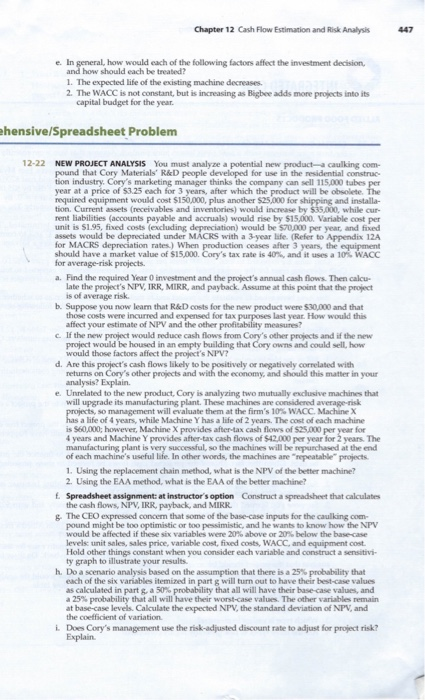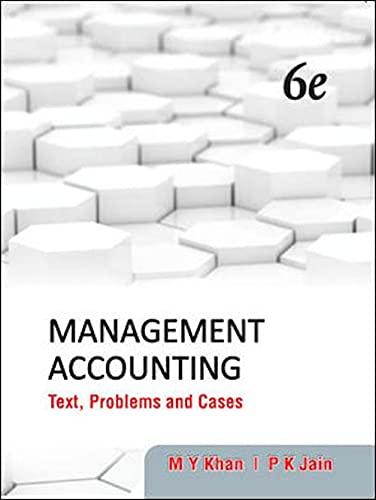Chapter 12 Cash Flow Estimation and Risk Analysis e. In general, how would each of the following factors affect the investment decision, and how should each be treated? 1. The expected life of the existing machine decreases. 2. The WACC is not constant, but is increasing as Bigbee adds more projects into its capital budget for the year. ehensive/Spreadsheet Problem 12-22 NEW PROJECT ANALYSIS You must analyze a potential new product caulking com- pound that Cory Materials R&D people developed for use in the residential construc tion industry. Cory's marketing manager thinks the company can sell 115.000 tubes per year at a price of 53.25 each for 3 years, after which the product will be obsolete. The required equipment would cost $150,000, plus another $25,000 for shipping and installa tion. Current assets (receivables and inventories) would increase by $35,000, while our rent liabilities (accounts payable and accruals) would rise by $15.000. Variable cost per unit is $1.95, fixed costs (excluding depreciation) would be 570.000 per year, and fixed assets would be depreciated under MACRS with a 3 year life. (Refer to Appendix 12A for MACRS depreciation rates) When production cases after 3 years, the equipment should have a market value of $15.000. Cory's tax rate is 40% and it uses a 10 WACC for average-risk projects a. Find the required Year O investment and the project's annual cash flows. Then calcu- late the project's NPV, IRR, MIRR, and payback Assume at this point that the project is of average risk b. Suppose you now learn that R&D costs for the new product were $30,000 and that those costs were incurred and expensed for tax purposes last year. How would this affect your estimate of NPV and the other profitability measures? c. If the new project would reduce cash flows from Cory's other projects and if the new project would be housed in an empty building that Cory owns and could sell, how would those factors affect the project's NPV? d. Are this project's cash flows likely to be positively or negatively correlated with returns on Cory's other projects and with the economy and should this matter in your analysis? Explain e Unrelated to the new product, Cory is analyzing two mutually exclusive machines that will upgrade its manufacturing plant. These machines are considered average-risk projects, so management will evaluate them at the firm's 10% WACC Machine X has a life of 4 years, while Machine Y has a life of 2 years. The cost of each machine is $60,000; however, Machine X provides after-tax cash flows of $25.000 per year for 4 years and Machine Y provides after-tax cash flows of $42.000 per year for 2 years. The manufacturing plant is very successful, so the machines will be repurchased at the end of each machine's useful life. In other words, the machines are repeatable projects 1. Using the replacement chain method, what is the NPV of the better machine? 2. Using the EAA method, what is the EAA of the better machine? Spreadsheet assignment: at instructor's option Construct a spreadsheet that calculates the cash flows, NPV, IRR, payback, and MIRR The CEO expressed concern that some of the base-case inputs for the caulking com pound might be too optimistic or too pessimistic, and he wants to know how the NPV would be affected if these six variables were 20% above or 20% below the base-case levels unit sales, sales price, variable cost, fixed costs, WACC, and equipment cost. Hold other things constant when you consider each variable and construct a sensitivi ty graph to illustrate your results. h. Do a scenario analysis based on the assumption that there is a 25% probability that each of the six variables itemized in part will turn out to have their best-case values as calculated in partga 50% probability that all will have their base-case values, and a 25% probability that all will have their worst-case values. The other variables remain at base-case levels. Calculate the expected NPV, the standard deviation of NPV, and the coefficient of variation i. Does Cory's management use the risk-adjusted discount rate to adjust for project risk? Explain Chapter 12 Cash Flow Estimation and Risk Analysis e. In general, how would each of the following factors affect the investment decision, and how should each be treated? 1. The expected life of the existing machine decreases. 2. The WACC is not constant, but is increasing as Bigbee adds more projects into its capital budget for the year. ehensive/Spreadsheet Problem 12-22 NEW PROJECT ANALYSIS You must analyze a potential new product caulking com- pound that Cory Materials R&D people developed for use in the residential construc tion industry. Cory's marketing manager thinks the company can sell 115.000 tubes per year at a price of 53.25 each for 3 years, after which the product will be obsolete. The required equipment would cost $150,000, plus another $25,000 for shipping and installa tion. Current assets (receivables and inventories) would increase by $35,000, while our rent liabilities (accounts payable and accruals) would rise by $15.000. Variable cost per unit is $1.95, fixed costs (excluding depreciation) would be 570.000 per year, and fixed assets would be depreciated under MACRS with a 3 year life. (Refer to Appendix 12A for MACRS depreciation rates) When production cases after 3 years, the equipment should have a market value of $15.000. Cory's tax rate is 40% and it uses a 10 WACC for average-risk projects a. Find the required Year O investment and the project's annual cash flows. Then calcu- late the project's NPV, IRR, MIRR, and payback Assume at this point that the project is of average risk b. Suppose you now learn that R&D costs for the new product were $30,000 and that those costs were incurred and expensed for tax purposes last year. How would this affect your estimate of NPV and the other profitability measures? c. If the new project would reduce cash flows from Cory's other projects and if the new project would be housed in an empty building that Cory owns and could sell, how would those factors affect the project's NPV? d. Are this project's cash flows likely to be positively or negatively correlated with returns on Cory's other projects and with the economy and should this matter in your analysis? Explain e Unrelated to the new product, Cory is analyzing two mutually exclusive machines that will upgrade its manufacturing plant. These machines are considered average-risk projects, so management will evaluate them at the firm's 10% WACC Machine X has a life of 4 years, while Machine Y has a life of 2 years. The cost of each machine is $60,000; however, Machine X provides after-tax cash flows of $25.000 per year for 4 years and Machine Y provides after-tax cash flows of $42.000 per year for 2 years. The manufacturing plant is very successful, so the machines will be repurchased at the end of each machine's useful life. In other words, the machines are repeatable projects 1. Using the replacement chain method, what is the NPV of the better machine? 2. Using the EAA method, what is the EAA of the better machine? Spreadsheet assignment: at instructor's option Construct a spreadsheet that calculates the cash flows, NPV, IRR, payback, and MIRR The CEO expressed concern that some of the base-case inputs for the caulking com pound might be too optimistic or too pessimistic, and he wants to know how the NPV would be affected if these six variables were 20% above or 20% below the base-case levels unit sales, sales price, variable cost, fixed costs, WACC, and equipment cost. Hold other things constant when you consider each variable and construct a sensitivi ty graph to illustrate your results. h. Do a scenario analysis based on the assumption that there is a 25% probability that each of the six variables itemized in part will turn out to have their best-case values as calculated in partga 50% probability that all will have their base-case values, and a 25% probability that all will have their worst-case values. The other variables remain at base-case levels. Calculate the expected NPV, the standard deviation of NPV, and the coefficient of variation i. Does Cory's management use the risk-adjusted discount rate to adjust for project risk? Explain







